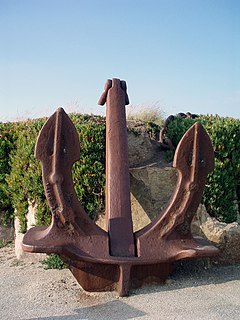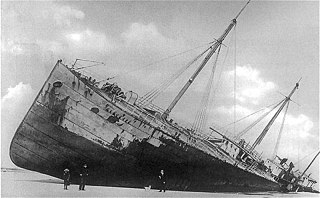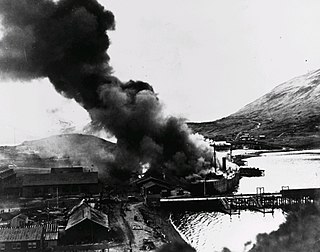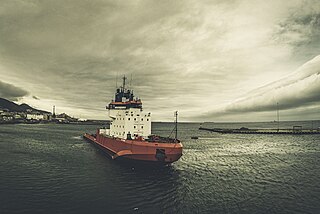
Kenai is a city in the Kenai Peninsula Borough in the U.S. state of Alaska. It is one hundred and eighty-seven miles south from Anchorage. The population was 7,100 as of the 2010 census, up from 6,942 in 2000.

Nikiski is a census-designated place (CDP) in Kenai Peninsula Borough, Alaska, United States. The population was 4,493 at the 2010 census, up from 4,327 in 2000.

Oriental Nicety, formerly Exxon Valdez, Exxon Mediterranean, SeaRiver Mediterranean, S/R Mediterranean, Mediterranean, and Dong Fang Ocean, was an oil tanker that gained notoriety after running aground in Prince William Sound spilling millions of barrels of crude oil in Alaska. On March 24, 1989, while owned by the former Exxon Shipping Company, and captained by Joseph Hazelwood and First Mate James Kunkel bound for Long Beach, California, the vessel ran aground on the Bligh Reef resulting in the second largest oil spill in United States history. The size of the spill is estimated to have been 40,900 to 120,000 m3, or 257,000 to 750,000 barrels. In 1989, the Exxon Valdez oil spill was listed as the 54th largest spill in history.

Prince William Sound is a sound of the Gulf of Alaska on the south coast of the U.S. state of Alaska. It is located on the east side of the Kenai Peninsula. Its largest port is Valdez, at the southern terminus of the Trans-Alaska Pipeline System. Other settlements on the sound, which contains numerous small islands, include Cordova and Whittier plus the Alaska native villages of Chenega and Tatitlek.

USS Antietam (CG-54) is a Ticonderoga-class guided missile cruiser of the United States Navy. Antietam was named for the site of the 1862 Battle of Antietam, Maryland, between Confederate forces under General Robert E. Lee and Union forces under Major General George McClellan, during the American Civil War. Antietam earned the 2007 and 2008 Battle Efficiency awards, also known as the Battle E award, for the John C. Stennis Strike Group. Antietam was out of operation for a while after running aground while trying to anchor in Tokyo Bay in January 2017.

USS Salinas (AO-19), a United States Navy Patoka-class replenishment oiler, was laid down for the United States Shipping Board (USSB) as Hudsonian (219592) on 10 April 1919 by the Newport News Shipbuilding and Dry Dock Co., Newport News, Virginia; launched on 5 May 1920; accepted by the USSB on 13 May 1920; transferred to the Navy on 29 October 1921; renamed Salinas and designated AO-19 on 3 November 1921; and commissioned at Mobile, Ala., on 16 December 1921, Lt. Comdr. H. S. Chase, USNRF, in command.

The Aegean Sea tanker oil spill was a spill that occurred on 3 December 1992 when the double-bottomed Greek-flagged oil tanker, Aegean Sea, en route to the Repsol refinery in A Coruña, Spain, suffered an accident off the Galician coast. The ship had successfully passed all required tests and revisions. The accident occurred during extreme weather conditions and affected the Galician coast resulting in ecosystem damage, as well as damage to the fishing and tourist industries in A Coruña. The captain and pilot were found to be criminally liable and the shipowner took on much of the monetary liability.
The MV Sea Empress was a single-hull Suezmax oil tanker that ran aground at the entrance to the Milford Haven harbour on the southwest coast of Wales in February 1996. The ensuing oil spill, Britain's third largest oil spillage and the 12th largest in the world at the time, devastated a considerable area of local coastline and killed many birds, and continued to affect the Pembrokeshire coast for years afterwards.

An oil tanker, also known as a petroleum tanker, is a ship designed for the bulk transport of oil or its products. There are two basic types of oil tankers: crude tankers and product tankers. Crude tankers move large quantities of unrefined crude oil from its point of extraction to refineries. For example, moving crude oil from oil wells in a producing country to refineries in another country. Product tankers, generally much smaller, are designed to move refined products from refineries to points near consuming markets. For example, moving gasoline from refineries in Europe to consumer markets in Nigeria and other West African nations.

USNS Shoshone (T-AO-151), later T-AO-151T, was a United States Navy Maumee-class oiler, later transport oiler, in non-commissioned service with the Military Sea Transportation Service (MSTS), later Military Sealift Command, from 1957 until probably the mid-1980s.

The Sea Empress oil spill occurred at the entrance to the Milford Haven Waterway in Pembrokeshire, Wales on 15 February 1996. The Sea Empress was en route to the Texaco oil refinery near Pembroke when she became grounded on mid-channel rocks at St. Ann's Head. Over the course of a week, she spilt 72,000 tons of crude oil into the sea. The spill occurred within the Pembrokeshire Coast National Park – one of Europe's most important and sensitive wildlife and marine conservation areas. It was Britain's third largest oil spillage and the twelfth largest in the world at the time.
Algonova was a single-hulled oil tanker launched in 1969 as Texaco Chief for Texaco Canada Ltd.. In 1986, the ship was renamed A. G. Farquharson. In 1995 the ship was sold to Imperial Oil. Purchased by Algoma Central in 1998, the ship was renamed Algonova. In 2007, Algoma Central sold the vessel to Belgrave Investors Corporation, which renamed the vessel Pacifico Trader. Helmer Business Incorporated acquired the vessel in 2012 and renamed the ship Great Portobello. The vessel is currently in active service.

Glückauf was a German ship that represented a major step forward in oil tanker design. "When the Glückauf sailed from the Tyne on 10 July 1886 she was the first ocean going tanker with oil to her skin". The vessel was in use from 1886 to 25 March 1893, when it ran aground at Fire Island in New York.

Kulluk was an ice-strengthened drill barge that was used for oil exploration in the Arctic waters. She was constructed by Mitsui Engineering & Shipbuilding in Japan in 1983 and operated in the Canadian Arctic until 1993 when she was mothballed for over a decade. In 2005, she was purchased and extensively refurbished by Royal Dutch Shell for the drilling operations off the northern coast of Alaska.

USCGC Liberty (WPB-1334) is an Island-class cutter of the United States Coast Guard. She is homeported at Auke Bay in Juneau, Alaska where she patrols territorial waters, including the Inside Passage. In 2016 she won the Hopley Yeaton Cutter Excellence Award for outstanding operational and humanitarian achievements.

The SS Northwestern, originally SS Oriziba, was a passenger and freight steamship launched in 1889 by the Delaware River Iron Ship Building and Engine Works, Chester, Pennsylvania which spent most of its career in service in the waters of the Territory of Alaska. The ship from early in its career had a reputation for trouble, and was frequently involved in groundings, collisions with other ships, and with port facilities. She first served as a transport in the West Indies as Oriziba, and was acquired by the Northwestern Steamship Company in 1906, sailed around Cape Horn, and renamed Northwestern. For the next thirty years she worked along the Alaska coast, transporting people, mail, and goods, as well as ore from mining operations at Kennecott.
SS Arrow was built by Bethlehem Steel Company, Sparrows Point, Baltimore, Maryland in 1948 as the tanker Olympic Games. Renamed the Sea Robin in 1960 and finally to Arrow in 1962, the ship was a Liberian-registered tanker. At 551.2 feet in length, 68.3 feet in width, and a draft of 29.9 feet, she was an enlarged version of the standard American wartime tanker design and one of the oldest tankers in the fleet of Aristotle Onassis, owned by the Sun Navigation Company. The Arrow ran aground and spilled its load of oil into Chedabucto Bay on February 4, 1970. It remains the most significant oil spill off Canada’s East Coast Only the MV Kurdistan comes close when that vessel spilled about 6,000 tons of oil after breaking apart just south of Cabot Strait on March 15, 1979.

Kigoriak is a Russian icebreaking anchor handling tug supply vessel. Built by Saint John Shipbuilding & Dry Dock Company for Canadian Marine Drilling (Canmar) in 1979 as Canmar Kigoriak, she was the first commercial icebreaking vessel developed to support offshore oil exploration in the Beaufort Sea.
City of Brunswick was a steam cargo ship built in 1921 by Oscar Daniels Shipbuilding Company of Tampa for the United States Shipping Board as part of the wartime shipbuilding program of the Emergency Fleet Corporation (EFC) to restore the nation's Merchant Marine. The freighter ran aground and was wrecked on her first commercial trip to Europe off Halifax in August 1921.
MV Seminole was a UK motor tanker. She was built in 1921 and ran aground in the River Mersey in 1927, causing an emergency in Liverpool when part of her cargo of petrol escaped into the river. She was scrapped in 1936.















